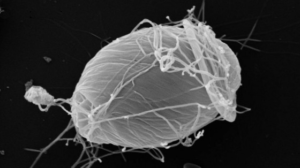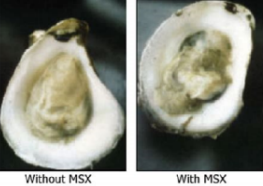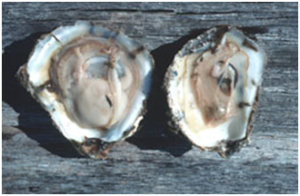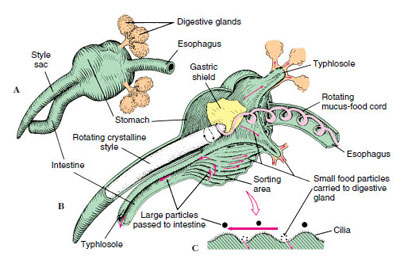
Eastern Oysters were once abundant in Barnegat Bay. Due to over harvesting and disease their numbers have been significantly reduced.
Eastern Oyster Crassostrea virginica
Eastern Oyster …Disease
Once plentiful in Barnegat Bay, the Eastern oyster had serious problems with two diseases.
MSX and Dermo
These diseases affect oysters but are not harmful to humans
MSX, a gill infection, can be observed within 3 weeks -Death occurs with 2 to 3 weeks.
Dermo may take up to 3 years before the oyster dies.
MSX
Oyster production in Chesapeake and Delaware bays has been severely depressed since the appearance of H. nelsoni in the late 1950s.
Geographical distribution
Infected oysters are found along the east coast of North America from Nova Scotia, Canada to Florida, USA.
Infections of H. nelsoni are rare at salinities below 10 ppt and intensify above 15 ppt
Cooler water temperatures also restrict growth.
Note: salinity – the concentration of dissolved salts in water, usually expressed in “parts per thousand” (ppt) Examples Freshwater – 0 ppt / Ocean 35 ppt / Bay (average) 20-25 ppt / Brackish 10-15 ppt
Selective breeding has been successful in producing highly resistant strains and the development of resistance through natural selection has been reported in some wild populations subjected to heavy infection pressure.
Management strategies include maintaining oysters at reduced salinities (< 15 ppt) as long as possible.
Dermo
Dermo disease was first identified as the cause of extensive oyster mortalities nearly fifty ago.
It was originally thought to be a fungus and was named Dermocystidium marinum. Even though subsequent research led to its reclassification as a protozoan parasite Perkinsus marinus in 1978, the disease is still commonly referred to as “Dermo.”
Today P. marinus is prevalent throughout the warm waters of the Gulf of Mexico and southeastern U. S.
In recent years its range has extended as far north as southern Maine in conjunction with high winter temperatures.
P. marinus is highly infectious, capable of spreading rapidly throughout a growing area.
The disease is transmitted directly from infected to uninfected oysters.
A decrease in growth is usually noted prior to mortality, which is typically between 40% and 90% after two to three years of exposure.
There is however, some good news.
As a result of Aquaculture more and more “Oyster Farmers” are making a living producing oysters for market and in turn help to make the bay cleaner.
Lorem ipsum dolor sit amet, consectetur adipiscing elit. Ut elit tellus, luctus nec ullamcorper mattis, pulvinar dapibus leo.



